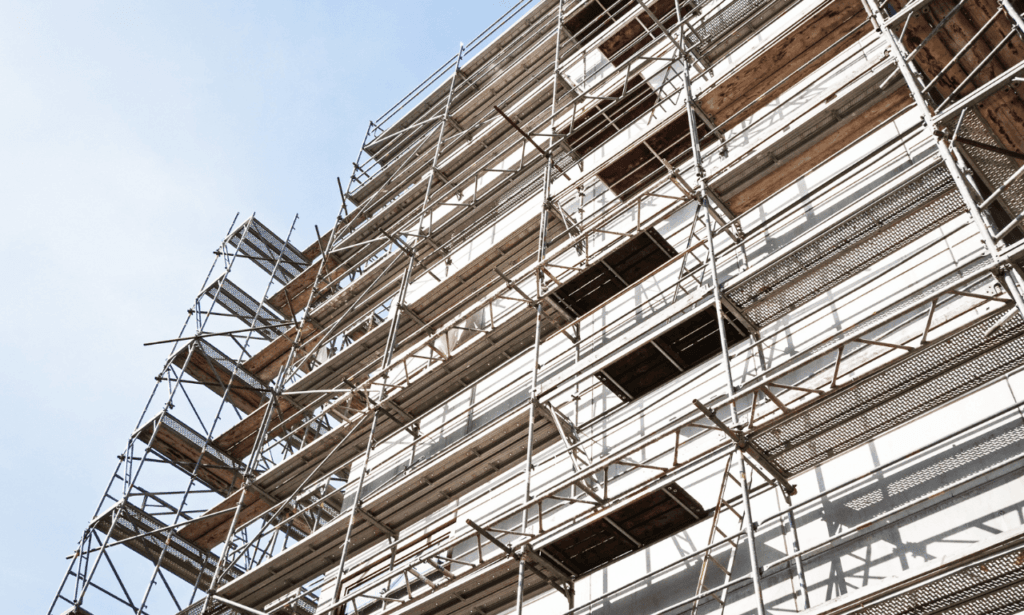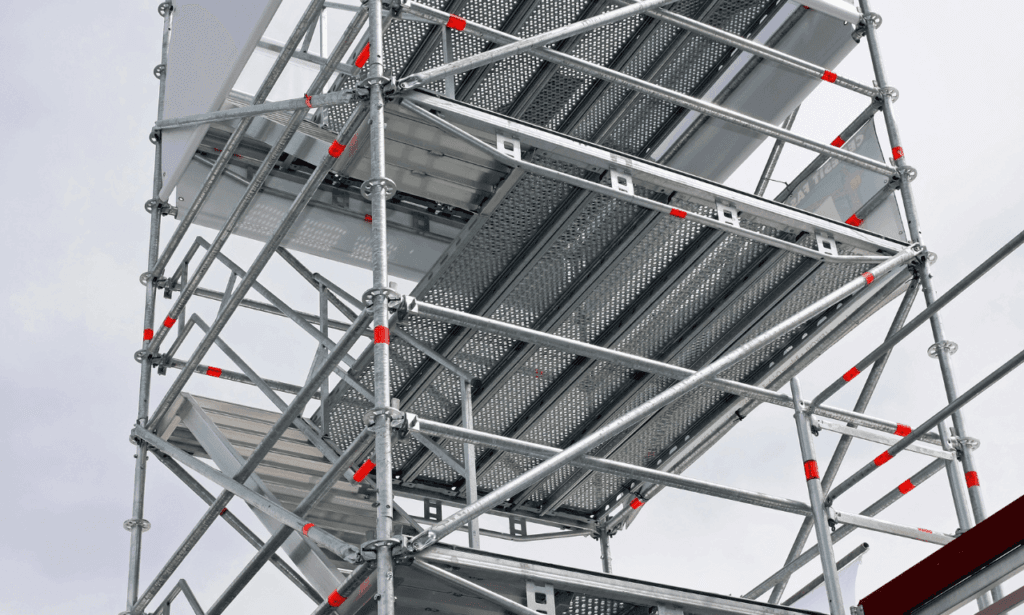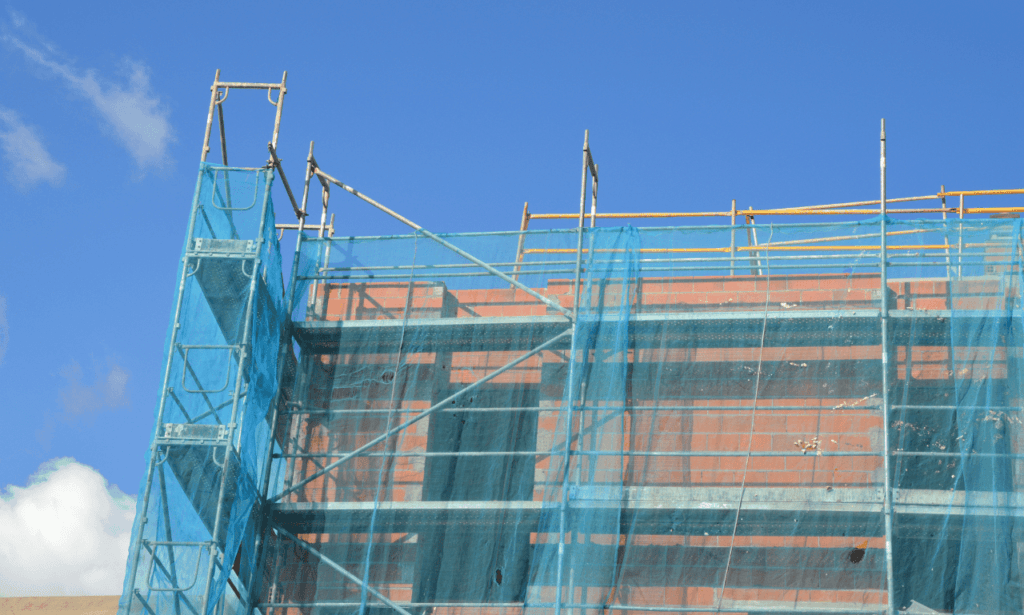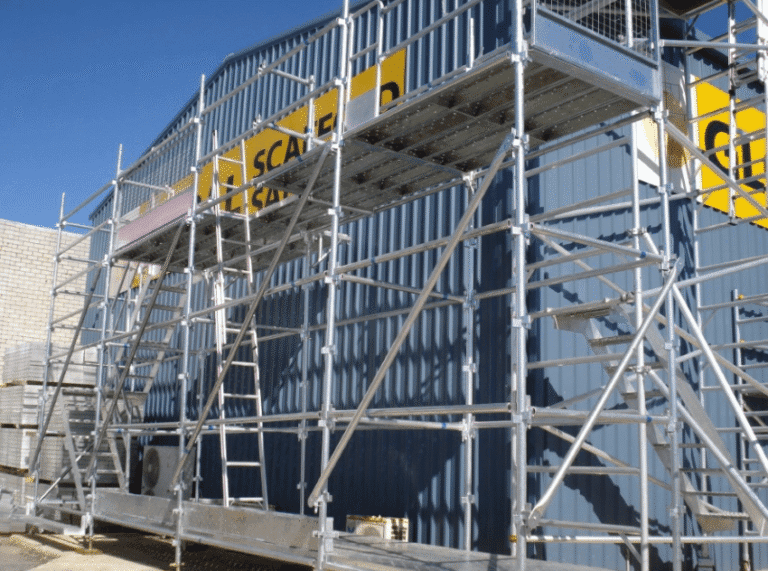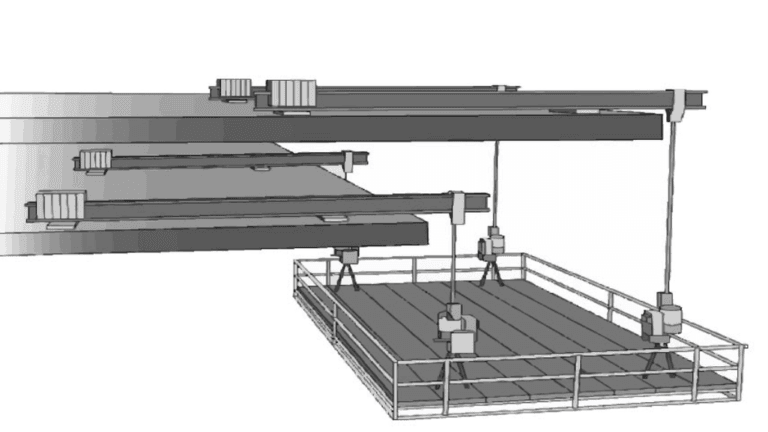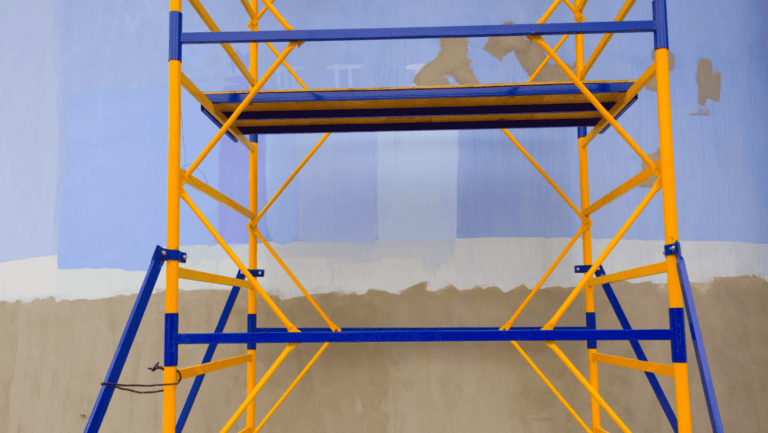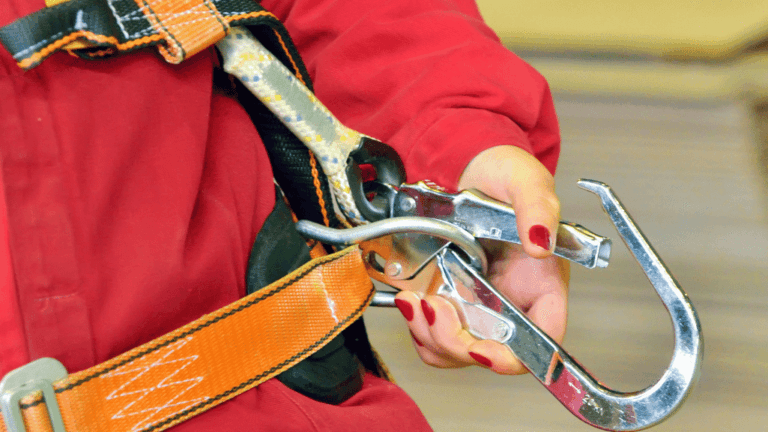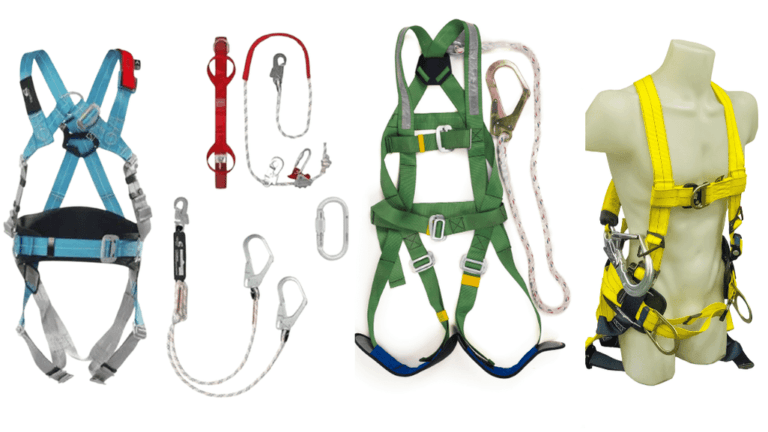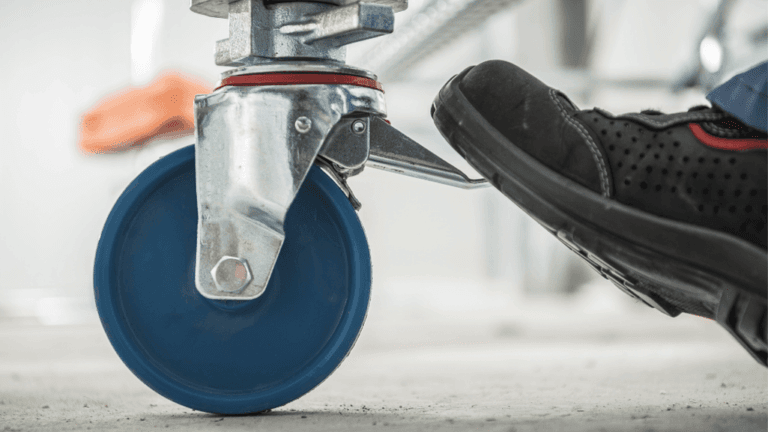Phone:
(+65)8319-0742
Scaffolding is key in the construction world. It gives workers safe access to high places. These temporary setups hold workers, tools, and materials during building, fixing, or upkeep.
Keeping scaffolding safe and strong is vital. It affects worker safety and project success.
Every year, about 4,500 people get hurt from scaffolding. This costs around $90 million in lost workdays. To lower these risks, scaffolding parts are made with a 4 to 1 safety margin. OSHA also requires at least 10 feet of space between electrical dangers and scaffolds to avoid accidents.
It’s important to check scaffolding often. These checks should happen at the start of each day and when the weather changes. A scaffold tagging system with green, yellow, and red tags helps workers know if a scaffold is safe.
New scaffolding tech, like modular systems and strong, light materials, make scaffolding safer and faster. These updates help set up scaffolding quicker, carry more weight, and make sites better.
Key Takeaways:
- Scaffolding structures are essential for providing safe access to work areas at height in construction projects.
- Proper design, regular inspections, and adherence to safety regulations are crucial for preventing scaffolding-related accidents and injuries.
- Advancements in scaffolding technology, such as modular systems and high-strength materials, have improved efficiency and safety on construction sites.
- Competent persons must conduct regular inspections and maintain a clear scaffold tagging system to ensure the safety of workers.
- Investing in engineering expertise and commitment to safety are fundamental to the success of scaffolding structure solutions.
Understanding the Basics of Scaffolding
Scaffolding is a temporary setup that helps workers reach high places safely. It’s used in construction, manufacturing, and maintenance. This structure is key for worker safety and efficiency.
Definition and Purpose of Scaffolding
Scaffolding is a temporary platform for workers and materials. It’s used for building, fixing, or maintaining structures. It makes working at heights safe and efficient.
Common Components of Scaffolding Systems
A scaffolding system has several important parts. These parts work together to create a safe platform for workers. The main components are:
- Base jacks and sole plates: These are at the bottom to spread the load evenly.
- Standards or uprights: These vertical tubes carry the weight to the ground.
- Ledgers and transoms: Horizontal tubes that connect the standards.
- Braces: Diagonal tubes that make the scaffolding more stable.
- Battens and board decking: Wooden or metal planks for the working platforms.
- Couplers, scaffold ties, and brackets: These connect and secure the scaffolding parts.
| Component | Purpose |
|---|---|
| Base plate | Spreads the load onto the sole plate |
| Sole plate | Distributes the load from the base plate to the ground |
| Standards (uprights) | Transfers the weight of the structure to the ground |
| Ledgers | Horizontal tubes connecting the standards |
| Transoms | Rest upon the ledgers at right angles |
| Bracing | Increases rigidity, placed diagonally from ledger to ledger |
A well-designed scaffolding system is essential for ensuring the safety and efficiency of workers in various industries. By understanding the basic components and their functions, project managers and contractors can create a secure and stable working environment that facilitates the successful completion of construction, maintenance, or repair projects.
Types of Scaffolding Structures
Scaffolding structures vary to meet different construction needs and site conditions. The main types are supported scaffolding, suspended scaffolding, and mobile scaffolding. They use materials like steel tubes and couplers, prefabricated systems, H-frames, timber, and bamboo.
Supported Scaffolding
Supported scaffolding is built from the ground up. It relies on the ground for support. It’s used for stable and secure work platforms in construction projects.
It has two main types:
- Single scaffolding is for brick masonry. It has standards, ledgers, and putlogs at 1.2 to 1.5 meters apart. Standards are 1.2 meters from the wall, with 2 to 2.5 meters between them.
- Double scaffolding, or independent scaffolding, is for stone masonry. It has two rows of standards, 20 to 30 cm and 1 meter from the wall. It has transoms and cross bracings for extra support.
Suspended Scaffolding
Suspended scaffolding hangs from a building’s edge. It uses wires, ropes, and chains for support. It’s great for high-level work like exterior painting and window cleaning.
It can be fixed, pulley-operated, or winch-operated, depending on the project’s needs.
Mobile Scaffolding
Mobile scaffolding is on wheels or casters. It’s easy to move and reposition. It’s perfect for short-term projects like painting and plastering.
It’s quick to set up and take down, making it flexible and efficient.
| Scaffolding Type | Materials | Applications |
|---|---|---|
| Tube and Coupler | Steel tubes and couplers | Versatile, adaptable to complex structures |
| Prefabricated Modular System | Standardized components | Quick assembly, suitable for repetitive structures |
| H-Frame / Facade | Modular frames | Ideal for facade work and masonry support |
| Timber | Wooden poles and planks | Lightweight, used in small-scale projects |
| Bamboo | Bamboo poles | Traditional, eco-friendly, common in Asia |
Ensuring Safety in Scaffolding Structure Solutions
Scaffolding safety is key in construction, affecting worker health and project success. OSHA says scaffolding issues are common, with falls causing most injuries and deaths. In 2020, there were 3,400 injuries and 52 deaths from scaffolding, costing about $90 million.
To avoid these problems, following OSHA rules is vital. It’s also important to check scaffolding regularly and keep it stable.
OSHA Regulations and Standards
OSHA has strict rules for scaffolding to reduce risks. Scaffolds must hold their own weight and four times the maximum load. This ensures they can handle workers, tools, and materials safely.
OSHA also requires a competent person to oversee scaffolding setup and removal. This ensures safety protocols are followed.
Load Bearing Capacity and Stability
Keeping scaffolding stable is crucial for safety. OSHA says scaffolds must support four times the maximum load. If they can’t, they might collapse.
To add stability, bracing and guying ties are used. These help prevent tipping and support heavier loads.
| Scaffolding Safety Requirement | OSHA Standard |
|---|---|
| Load Bearing Capacity | 4 times the maximum intended load |
| Guardrail Installation Height | 38-45 inches above the platform |
| Base-to-Height Ratio (without guying/ties/bracing) | 4:1 |
Regular Inspections and Maintenance
Regular checks are vital for scaffolding safety. OSHA says supervisors must inspect scaffolding monthly. They must replace any damaged parts right away.
Inspectors should look for any damage to the scaffolding. This includes cuts, bends, or rust. Fixing these problems quickly keeps the scaffolding safe.
“Training of workers on recognizing, controlling, and reducing hazards while using scaffolds is crucial for ensuring safety.” – OSHA
It’s also important to train workers on safe scaffolding use. This training should cover:
- Recognizing and controlling hazards
- Proper use of fall protection systems
- Safe access and egress procedures
- Emergency response plans
By following OSHA rules, keeping scaffolding stable, and training workers, employers can make construction safer. This reduces the risk of accidents and injuries.
Choosing the Right Scaffolding Structure for Your Project
Choosing the right scaffolding is key for safety, efficiency, and saving money in any project. It depends on many things like the project needs, the type of construction, where it’s located, and more.
First, think about if the project is indoors or outdoors. Outdoor projects need strong, weather-resistant scaffolding like steel scaffolding. It’s strong and doesn’t catch fire. Indoor projects might use lighter scaffolding like aluminum or mobile systems.
The type of construction and how big it is also matter. Big projects like high-rise buildings need supported scaffolding for safety. For smaller sites or working high up, suspended scaffolding is better.
Also, think about the site’s surface. If it’s uneven or can’t handle regular scaffolding, use cantilever scaffolding. Trestle scaffolding works well for low-level work and indoor projects.
“Proper selection and use of scaffolding can significantly reduce construction costs by streamlining work processes and enhancing safety.”
The project’s height is important too. For lower projects, use supported or trestle scaffolding. For higher ones, cantilever or suspended scaffolding is better. Make sure the scaffolding can hold the weight of workers, tools, and materials.
The materials of the project also affect the scaffolding choice. Steel scaffolding is durable and cost-effective. It’s easy to set up and take down. Patented scaffolding is also popular for its adjustable platforms.
Consider the workers’ skills and how many you need. Some scaffolding needs experts to install. Always train workers and use safety gear like guardrails and non-slip platforms. Regular checks are also key to safety and success.
| Scaffolding Type | Suitable Projects | Key Features |
|---|---|---|
| Supported Scaffolding | High-rise buildings, outdoor projects, long-term projects | Stable base, easy access to materials and tools |
| Suspended Scaffolding | High-rise buildings, short-term maintenance work, limited access sites | Ideal for working at heights, minimal ground disturbance |
| Mobile Scaffolding | Indoor projects, painting, drywall installation, frequent relocation | Flexibility, ease of movement, time and cost-saving |
In summary, picking the right scaffolding means thinking about many things. Consider the project needs, construction type, location, and more. By focusing on safety, efficiency, and cost, you’ll make your project a success.
Factors Affecting Scaffolding Efficiency
Scaffolding efficiency is key to construction project success. Material choice, assembly and disassembly, and worker skill all matter. Improving these areas boosts productivity, safety, and cost-effectiveness.
Material Selection
The materials used in scaffolding affect its efficiency and safety. Steel and aluminum are common choices. Steel is durable, while aluminum is lighter but less strong.
Composite materials are also used, especially where electrical risks are high. Choosing the right material is crucial for efficiency.
Proper Assembly and Disassembly
Efficient scaffolding needs good assembly and disassembly. The erection procedures must be planned carefully. Safety is a top priority.
Before starting, check the soil’s strength and ensure a solid base. Safety checks should be regular during assembly. Disassembly should be systematic to keep components in good shape.
Scaffolding efficiency increases by 60% when a solid foundation is present, enabling workers to focus on tasks without safety concerns.
Skilled Labor and Training
The skill and training of workers are vital for scaffolding efficiency. A competent person must oversee the work. They ensure safety and follow best practices.
Workers need training in scaffolding, safety, and material handling. Regular training keeps skills sharp, reducing accidents and boosting productivity.
| Factor | Impact on Efficiency |
|---|---|
| High-quality materials | Reduces risk of collapse by 75% |
| Compliance with specifications | Reduces risk of collapse by 80% |
| Safety regulations | Decreases accidents by 70% |
| Skilled labor and training | Reduces work-related injuries by 55% |
By focusing on these areas, construction companies can improve scaffolding efficiency. This leads to safer work, faster projects, and better results. Investing in quality materials, proper procedures, and skilled workers is essential.
Advancements in Scaffolding Technology
The scaffolding industry has seen big changes lately. These changes make construction safer and more efficient. They also help make scaffolding systems stronger.
New materials and designs are key to these improvements. The industry keeps getting better to meet today’s construction needs.
Modular Systems and Prefabricated Components
Modular scaffolding systems are now more popular. They have standard parts that can be easily swapped out. This makes setting up scaffolding faster and more efficient.
Pre-made parts like platforms and brackets also help. They make the construction process smoother. Contractors can easily adjust to different project needs, keeping things stable and reducing changes on site.
Lightweight and High-Strength Materials
New materials like aluminum alloys are making scaffolding better. They are strong and can handle harsh weather, perfect for tough projects. Carbon fiber composites are also being used more. They are very strong but light, making scaffolding systems more stable and less heavy.
Diagonal bracings in tall scaffolding have also improved. Now, steel pipes are used instead of wood. This makes the scaffolding stronger and more stable. The mix of new materials and smart design makes scaffolding safer and more efficient.
| Material | Benefits | Applications |
|---|---|---|
| Aluminum Alloys | Lightweight, durable, corrosion-resistant | Bridge construction, marine environments |
| Carbon Fiber Composites | High strength-to-weight ratio, lightweight | Specialized scaffolding components, aerospace industry |
| Tubular Steel | High load-bearing capacity, structural stability | Tall building scaffolding, diagonal bracings |
The integration of advanced composite materials like carbon fiber and polymers is expected to replace traditional steel scaffolding in the coming years, offering unparalleled strength and durability.
The scaffolding industry will keep getting better. We’ll see even lighter, stronger, and greener materials. These changes will make construction safer and more efficient all over the world.
Best Practices for Scaffolding Structure Maintenance
Keeping scaffolding safe and lasting is key. Galvanizing steel tubes fight rust well, but you still need to check for damage. If you find bent, cracked, or corroded parts, replace them right away to keep the scaffolding strong.
Bamboo and timber scaffolds need more checks because they can rot or get bugs. Look for rot, bugs, or weak spots often. Storing scaffolding parts in a dry place helps prevent damage from rain and wind.
“Following the rules for scaffolding care is not just the law. It’s also a duty to keep workers and the public safe.”
Here are some tips to keep scaffolding safe and working well:
- Do a full check before and after using it, and fix any problems fast
- Swap out any worn or broken parts right away, using parts that match the original
- Keep moving parts clean and well-lubricated to stop rust and keep things running smoothly
- Store scaffolding parts neatly to protect them from weather and damage
- Teach workers how to take care of scaffolding and follow safety rules
| Maintenance Task | Frequency | Benefits |
|---|---|---|
| Visual inspection | Before and after each use | Finds problems early to avoid accidents |
| Replacement of damaged parts | As needed | Keeps the structure safe and prevents falls |
| Cleaning and lubrication | Monthly or as needed | Stops rust and keeps things working well |
| Proper storage | When not in use | Helps scaffolding last longer |
Following these tips and the rules can greatly lower the chance of accidents on scaffolding. Safety steps and training can cut down on accidents by half. This shows how important it is to take care of scaffolding in any building project.
Case Studies: Successful Scaffolding Structure Solutions
Scaffolding Solutions has a long history of providing safe and efficient scaffolding solutions. They have worked on many projects, from high-rise developments to historic building restorations. Their expertise in innovative solutions is unmatched.
Commercial Building Construction
In the commercial sector, Scaffolding Solutions has tackled big projects. They worked on a stadium that stood 90 feet high. The team faced challenges in accessing the building.
To solve these problems, they used creative methods. They ran tieback anchors across a 300-foot roof and secured them with parapet hooks. They also used swing stage scaffolding without roof anchors.
Their design included four BISOMAC hoists and 45-foot Altrex platforms. They also had Beta Max Leo hoists for lifting glass panels. This setup allowed for safe work on the facade, saving costs and speeding up the project.
Industrial Plant Maintenance
Scaffolding Solutions has also helped with facility upgrades in industrial settings. They installed support platforms with tight tolerances for heavy columns. The project was worth about 2.5 million dollars.
Their team planned and executed the project with precision. They ensured the platforms were installed safely and accurately. This allowed the maintenance work to proceed smoothly.
Historic Building Restoration
Restoring historic buildings is challenging due to their delicate nature. In Winnsboro, Texas, Scaffolding Solutions set up scaffolding to prevent accidents. They ensured the scaffolding was sturdy to handle heavy stucco pieces.
In Linden, Texas, they worked on a residential chimney restoration. They used specialized scaffolding to improve safety and speed up the project.
Scaffolding Solutions prioritizes safety, efficiency, and customer satisfaction. Their commitment to these values is reflected in the positive feedback from clients.
“Scaffolding Solutions delivered the project on time, despite the challenges we faced. Their team’s expertise and dedication to safety were invaluable in ensuring the success of our construction project.” – Commercial Building Developer
“The customized scaffolding solution provided by Scaffolding Solutions was instrumental in the efficient and safe completion of our facility upgrades. Their attention to detail and proactive approach saved us time and money.” – Industrial Plant Manager
With a strong track record and satisfied clients, Scaffolding Solutions leads the way in scaffolding solutions.
Conclusion
Safe practices and efficiency are key to success with scaffolding. Proper planning and following OSHA rules are crucial. Using expert professionals is also vital for safety and productivity.
New scaffolding tech, like lightweight materials and modular systems, boosts safety and efficiency. These modern scaffolding techniques make setup and teardown easier. They also give workers a safer place to work.
For any scaffolding project to succeed, following best practices is essential. This includes regular checks, upkeep, and skilled workers. By focusing on these areas and using the latest scaffolding tech, teams can finish their work safely and efficiently. This applies to building new structures, maintaining industrial sites, or restoring old buildings.


